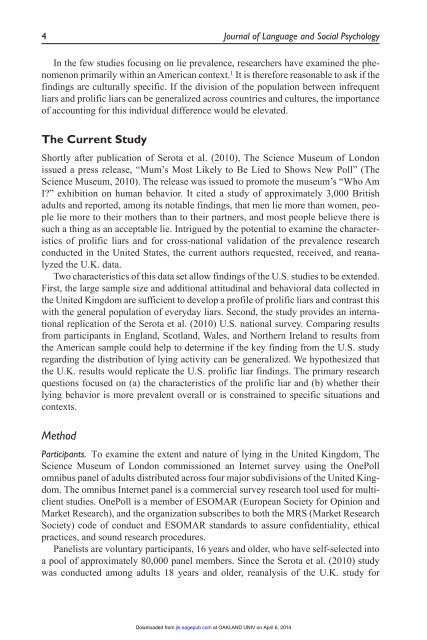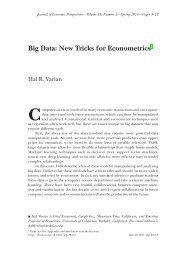You also want an ePaper? Increase the reach of your titles
YUMPU automatically turns print PDFs into web optimized ePapers that Google loves.
4 Journal of Language and Social Psychology<br />
In the few studies focusing on lie prevalence, researchers have examined the phenomenon<br />
primarily within an American context. 1 It is therefore reasonable to ask if the<br />
findings are culturally specific. If the division of the population between infrequent<br />
liars and prolific liars can be generalized across countries and cultures, the importance<br />
of accounting for this individual difference would be elevated.<br />
The Current Study<br />
Shortly after publication of <strong>Serota</strong> et al. (2010), The Science Museum of London<br />
issued a press release, “Mum’s Most Likely to Be Lied to Shows New Poll” (The<br />
Science Museum, 2010). The release was issued to promote the museum’s “Who Am<br />
I” exhibition on human behavior. It cited a study of approximately 3,000 British<br />
adults and reported, among its notable findings, that men lie more than women, people<br />
lie more to their mothers than to their partners, and most people believe there is<br />
such a thing as an acceptable lie. Intrigued by the potential to examine the characteristics<br />
of prolific liars and for cross-national validation of the prevalence research<br />
conducted in the United States, the current authors requested, received, and reanalyzed<br />
the U.K. data.<br />
Two characteristics of this data set allow findings of the U.S. studies to be extended.<br />
First, the large sample size and additional attitudinal and behavioral data collected in<br />
the United Kingdom are sufficient to develop a profile of prolific liars and contrast this<br />
with the general population of everyday liars. Second, the study provides an international<br />
replication of the <strong>Serota</strong> et al. (2010) U.S. national survey. Comparing results<br />
from participants in England, Scotland, Wales, and Northern Ireland to results from<br />
the American sample could help to determine if the key finding from the U.S. study<br />
regarding the distribution of lying activity can be generalized. We hypothesized that<br />
the U.K. results would replicate the U.S. prolific liar findings. The primary research<br />
questions focused on (a) the characteristics of the prolific liar and (b) whether their<br />
lying behavior is more prevalent overall or is constrained to specific situations and<br />
contexts.<br />
Method<br />
Participants. To examine the extent and nature of lying in the United Kingdom, The<br />
Science Museum of London commissioned an Internet survey using the OnePoll<br />
omnibus panel of adults distributed across four major subdivisions of the United Kingdom.<br />
The omnibus Internet panel is a commercial survey research tool used for multiclient<br />
studies. OnePoll is a member of ESOMAR (European Society for Opinion and<br />
Market Research), and the organization subscribes to both the MRS (Market Research<br />
Society) code of conduct and ESOMAR standards to assure confidentiality, ethical<br />
practices, and sound research procedures.<br />
Panelists are voluntary participants, 16 years and older, who have self-selected into<br />
a pool of approximately 80,000 panel members. Since the <strong>Serota</strong> et al. (2010) study<br />
was conducted among adults 18 years and older, reanalysis of the U.K. study for<br />
Downloaded from jls.sagepub.com at OAKLAND UNIV on April 6, <strong>2014</strong>



